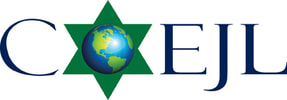|
My name is Becca Amdur-Kass, and I have been a COEJL (Coalition on the Environment and Jewish Life) policy intern this summer; I’m also a rising sophomore at Alfred University in New York, and a member of Adat Shalom Reconstructionist Congregation in Bethesda MD.
It’s been an honor to attend coalition meetings, reach out to Jewish leaders about policy matters, shape and generate educational materials, and advocate on behalf of a better future for all. One particular highlight was attending the Citizens Climate Lobby (CCL) Summer Conference in June. Here are a few reflections on what I learned – and what we might all learn:
4 Comments
Today (6/28/24), the US Supreme Court imposed a major setback on federal agencies’ ability to apply their expertise in the name of public safety and environmental protection. We at the Coalition on the Environment and Jewish Life are pained, and outraged – and, redoubled in our commitment to Jewish advocacy toward sustainability and justice.
We more or less know right from wrong, in general -- and regarding what we're doing to the biosphere, we are mostly clued in. Why then, even when we know better, do we keep making unsustainable, unjust, and ultimately unwise choices? Why the giant gap between our values and our actions?
To be better aligned, we must first “mind the gap” -- notice it, focus on it, even feel bad about it -- then bridge the gap, and ultimately close it. Jewish tradition promotes a structure for this ongoing ethical-spiritual introspection and sustained self-improvement: Mussar. The world as a whole can use this, right now. Lives will be saved, public health and climate goals advanced, and harmful pollution abated due to the EPA’s new light-duty vehicle standards announced earlier today. COEJL is grateful to the agency and the Biden Administration for this important step toward environmental and climate justice:
Polluters should pay – sounds pretty basic, right?! This week, in Annapolis, I had the honor of teaching a little Talmud while testifying on this “polluter pays principle.” And Marylanders, especially those in District 15 (which includes Adat Shalom), can now make their voice heard on this, too.
The RENEW Act -- a bill before the Maryland Senate committee chaired by Montgomery County (District 15)’s Sen. Brian Feldman, and co-chaired by neighboring Sen. Cheryl Kagan (who is already a cosponsor) -- would generate $900 million per year over the coming decade, to help Maryland adapt to the growing ravages of climate change, and limit or ‘mitigate’ its future emissions. |
CategoriesAUthorRabbi Fred Scherlinder Dobb, an eco-Jewish teacher-writer-organizer for over three decades, is COEJL's new Rabbinic Consultant. Fred serves on the national board of Interfaith Power and Light, and remains active in Jewish and multifaith efforts toward justice and sustainability. Please reach out if he or others at COEJL can work with you in some way, raising eco-Jewish awareness and action. authorIsrael Harris (he/him), a community and advocacy organizer, is COEJL's new Advocacy Director, and NRPE's new Policy Director. As an educator and youth advocate, Israel also supports Reform youth at the URJ, and continues working in support of our Jewish, multifaith, and justice-focus communities striving for equity and sustainability. |
[email protected]
Coalition on the Environment and Jewish Life is a project of a consortium of Jewish agencies, alongside allies, under the umbrella of the National Religious Partnership for the Environment.
In-Person meetings, across from U.S. Capitol: co/ NRPE, 110 Maryland Ave. NE, Su 203 -- Washington DC 20002
Mailings/Checks: c/o NRPE, 2529 Holkham Drive, Charlottesville, VA 22901
Coalition on the Environment and Jewish Life is a project of a consortium of Jewish agencies, alongside allies, under the umbrella of the National Religious Partnership for the Environment.
In-Person meetings, across from U.S. Capitol: co/ NRPE, 110 Maryland Ave. NE, Su 203 -- Washington DC 20002
Mailings/Checks: c/o NRPE, 2529 Holkham Drive, Charlottesville, VA 22901

